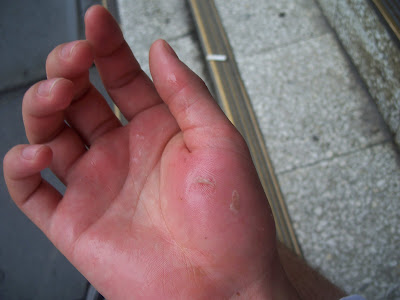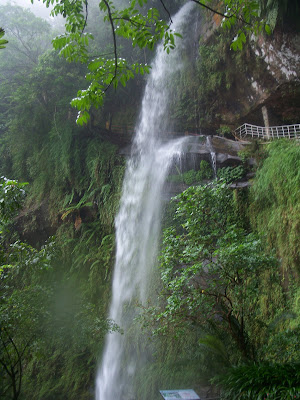On my way to these esteemed gardens, I met a jolly soul on the bus. His English was quite good and he told me all about life, well actually, all about his life. He told me that the location I was heading happened to be where the government stores all their top secret, classified documents. He told me he moved away from mainland China because his brother was a high ranking officer there. He also told me that he was eighty years old. During this delightful yet obviously disjointed conversation, I asked two questions and received two surprising answers from him.
The first question was about his destination. He told me he was returning home after visiting his wife. I found this odd and asked him to explain. Well, as it turns out, he likes the mountains and his wife likes the city, so rather than living together, they each have their own apartment and he goes to visit her each day. The second question revolved around why he had such a high command of the English language. Well, as it turns out, he used to serve in the Navy, hence his expatriation from his brother I suppose, and studied at various naval academies in the United States. I then asked if he had ever been to the Groton Sub Base, and as it turns out, he had! This was a delightful coincidence because I went to college at Connecticut College, which happens to be on the opposite side of the Thames River.
When I arrived at the terminal stop on the bus line, I was once again in my element, surrounded by mountains and greenery. I took to a small path and climbed my way up some hefty flights of stairs. At this point, I am beginning to notice a pattern in Taiwanese hiking paths. Rather than winding normally up the side of the mountain, the Taiwanese clearly prefer the direct, and thus more strenuous straight up shoot.

Half way up, I decided to sojourn at a cool wading pool. Little did I know this would be the turning point of my little stroll up the mountainside. I dipped my already wet feet into the cool of the stream and took some lovely photographs of the rushing water. Satisfied with my rest, I gathered my belongings and took off over some wet, slanted rocks. Up until this point, I had taken extreme caution over my steps, ensuring a safe and enjoyable hike. However, a momentary lapse of judgment sent me over those slippery rocks and before I know it, my balance was thrown off kilter.
Half way up, I decided to sojourn at a cool wading pool. Little did I know this would be the turning point of my little stroll up the mountainside. I dipped my already wet feet into the cool of the stream and took some lovely photographs of the rushing water. Satisfied with my rest, I gathered my belongings and took off over some wet, slanted rocks. Up until this point, I had taken extreme caution over my steps, ensuring a safe and enjoyable hike. However, a momentary lapse of judgment sent me over those slippery rocks and before I know it, my balance was thrown off kilter.
I threw my guide book up into the air, and the protruding weight of the sack on my back took me hard to the ground. My right rand slammed intensely onto a nearby rock, sending the most excruciating pains through my right arm. As soon as my hand made contact with the rock, I knew some serious damage had occurred.

Knowing that swelling would soon overtake my hand, I needed to get ice on it quickly. However, I was alone in the middle of the woods, and the closest 7/11 would be about 45 minutes away, providing me with no help. Thinking quickly, I looked at the stream and decided to put my hand into it to keep it cold. I had remembered hearing once that, in addition to keeping an injured body part cold, you ought to keep it dry as well. However, the heavy rain at this point removed this option from me, leaving me with no choice but to douse my hand in the cold water.
Knowing that swelling would soon overtake my hand, I needed to get ice on it quickly. However, I was alone in the middle of the woods, and the closest 7/11 would be about 45 minutes away, providing me with no help. Thinking quickly, I looked at the stream and decided to put my hand into it to keep it cold. I had remembered hearing once that, in addition to keeping an injured body part cold, you ought to keep it dry as well. However, the heavy rain at this point removed this option from me, leaving me with no choice but to douse my hand in the cold water.
Unfortunately, this is a sub-tropical island and the water wasn't really that cold. I had to make a decision- should I turn back for help, or get to the waterfall. I knew that I wouldn't be able to get anywhere fast enough to get immediate aid, so I saw no harm in finishing the hike up to the waterfall. And boy, was I glad I did.

The waterfall shoots over the cliff at an impressive 60 meters. Due to the heavy rain, the waterfall was particularly impressive. Although I didn't spend long at the waterfall, I did have enough time to explore its more immediate charm. For instance, you can enter into a cave that goes behind the waterfall, up to a small temple and get stunning views of the cascades and valley.
But with the throbbing pain, I knew it was time to return back down the mountainside. Slowly traversing the slippery steps, one by one, I eventually made it down to the roadside and into a 7/11. I have learned many words here, and it's always good to be in a situation where you are required to use them. At this time, I was beyond joy at the fact that I could ask, "Do you have any ice?"
Deprived of the use of my right hand, my grand companion, I was forced to turn to my often neglected left hand. Over the next few days, my left hand and I got very close as I learned to shower and get dressed, write, and even use chopsticks with it. The experiences were frustrating, but achievable.

The bandages are now off, and aside from a very deep bruise, my hand is back in working condition. So from your born again lefty in Taiwan, please follow my advice: if you are going to go hiking in the rain, take an umbrella. Your friend, Michael.


